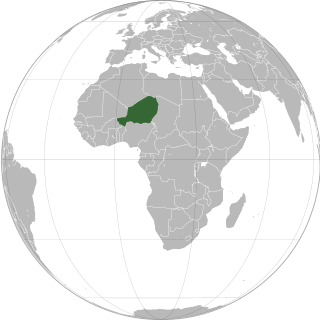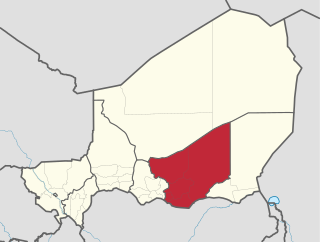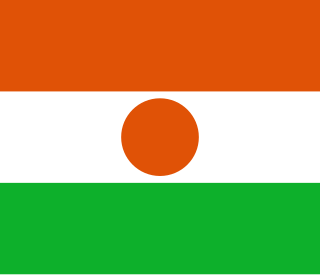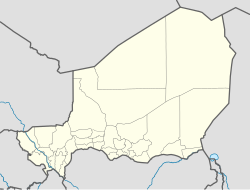
Niger or the Niger, officially the Republic of the Niger, is a landlocked country in West Africa. It is a unitary state bordered by Libya to the northeast, Chad to the east, Nigeria to the south, Benin and Burkina Faso to the southwest, Mali to the west, and Algeria to the northwest. It covers a land area of almost 1,270,000 km2 (490,000 sq mi), making it the largest landlocked country in West Africa. Over 80% of its land area lies in the Sahara. Its predominantly Muslim population of about 25 million lives mostly in clusters in the south and west of the country. The capital Niamey is located in Niger's southwest corner.

The Tuareg people are a large Berber ethnic group that principally inhabit the Sahara in a vast area stretching from far southwestern Libya to southern Algeria, Niger, Mali, and Burkina Faso. Traditionally nomadic pastoralists, small groups of Tuareg are also found in northern Nigeria.

Agadez Region is one of the seven regions of Niger. At 667,799 square kilometres (257,839 sq mi), it covers more than half of Niger's land area, and is the largest region in the country, as well as the largest African state subdivision. The capital of the department is Agadez.

Zinder Region is one of the seven regions of Niger; the capital of the region is Zinder. The region covers 145,430 km². It is the most populous province of Niger.

Nordic Africa Institute (NAI) (Swedish: Nordiska Afrikainstitutet) serves as a research, documentation and information centre on modern Africa for the Nordic countries. The Institute conducts independent, policyrelevant research, provides analysis and informs decisionmaking, with the aim of advancing research-based knowledge of contemporary Africa.
Bani-Bangou is a town in southwestern Niger, in rural northern Ouallam Department, Tillabéri Region. It is the capital of the rural commune of Bani-Bangou. On the main highway from Ouallam on the route to the Malian border town of Andéramboukane. It is 135 km northeast of Ouallam and 70 km by road from Mali. It around 200 km cross country from Niamey. The town is the seat of a "Rural Commune" of the same name, one of four rural communes in the department. Nearby villages include Gorou, Bassikwana, and Tondi Tiyaro Kwara to the north; Koloukta and Dinara along the highway west; Ouyé to the southeast.

According to the Republic of Niger's Constitution of 1999, most human rights, as defined by the Universal Declaration of Human Rights, are upheld and protected. Despite these protections, concerns of both domestic and international human rights organizations have been raised over the behavior of the government, military, police forces, and over the continuation of traditional practices which contravene the 1999 constitution. Under French colonial rule (1900–1960) and from independence until 1992, citizens of Niger had few political rights, and lived under arbitrary government power. Although the situation has improved since the return to civilian rule, criticisms remain over the state of human rights in the country.

The following outline is provided as an overview of and topical guide to Niger:
Dabaga is a town and rural commune in the Agadez Region of northern Niger. The town is situated around 50 kilometers north of the regional capital, Agadez, on the main road leading north into the Aïr Mountains and the town of Elmeki. Like the nearby communities of Azel, Elmeki and Egandawel, Dabaga is an oasis in the Aïr Massif valleys, populated by both sedentary and semi-nomadic Tuaregs and small numbers of Hausa and other groups. According to UNICEF, Dabaga had a permanent population of 35,000 in early 2007, mostly families of Tuareg pastoralists, where the adult males traveled with their herds.
Akoubounou, or Akabinu in the local Tin Sert language, is a village located in the west to the town of Abalak, in the Tahoua Region of Niger.
Mass media in Niger is a diverse collection of public and private entities, both print and broadcast, centered in the capital of Niamey, but with vibrant regional centers. The media has historically been state funded, and focused on radio broadcast media, as the nation's population is spread over great distances. Niamey boasts scores of newspapers and magazines, many of which are fiercely critical of the government. These papers though have very small circulations, and almost none outside the cities.

The government of Niger is the apparatus through which authority functions and is exercised: the governing apparatus of Nigerien state. The current system of governance, since the Constitution of 25 November 2010, is termed the Seventh Republic of Niger. It is a semi-presidential republic, whereby the President of Niger is head of state and the Prime Minister of Niger head of government. The officials holding these posts are chosen through a representative democratic process of national and local elections, in the context of a competing multi-party system. Executive power is exercised by the government. Legislative power is vested in both the government and the National Assembly. The judiciary is independent of the executive and the legislature: its Constitutional Court has jurisdiction over constitutional and electoral matters.
The Ikelan are a caste within Tuareg society, who were at one time slaves or servile communities.
Bankilaré is a village and rural commune in Niger. Bankilaré commune, centered on the town of the same name, is in Téra Department, Tillabéri Region, in the northwestern corner of the country. The town lies 60 km north of Departmental capital Téra, and around the same distance from the Burkina Faso border and the Mali border. As of 2012, it had a population of 84,893.
N'Guelbély is a village and rural commune in Niger.
Tamaske is a city and rural commune in Niger. It is located in the Keita Department, in the Tahoua Region.
Tarka, Niger is a village and rural commune in Niger. It is located in the Belbédji Departement of the Zinder Region. As of 2012 the commune had a population of 96,452.

Tassara is a village and rural commune in Niger.
Tondikandia is a rural commune in Filingué Department, Tillabéri Region, Niger. Its chief place and administrative center is the town of Damana.

Slavery in Niger involves different practices which have been practiced in the Sahel region for many centuries and which persist to this day. The Bornu Empire in the eastern part of Niger was an active part of the trans-Saharan slave trade for hundreds of years. Other ethnic groups in the country similarly had a history of slavery, although this varied and in some places slavery was largely limited to the political and economic elite. When the French took control of the area, they largely ignored the problem and only actively banned the trade in slaves but not the practices of slavery. Following independence, many of the major slave holders became prominent political leaders in both the multiparty democracy period and the military dictatorship, and so the problem of slavery was largely ignored. In 2003, with pressure from the anti-slavery organization Timidria, Niger passed the first law in Western Africa that criminalized slavery as a specific crime. Despite this, slavery persists throughout the different ethnic groups in the country, women are particularly vulnerable, and a 2002 census confirmed the existence of 43,000 slaves and estimated that the total slave population could be over 870,000 people. The landmark Mani v. Niger case was one of the first instances where a person won a judgement against the government of Niger in an international court for sanctioning her slave status in official decisions.










